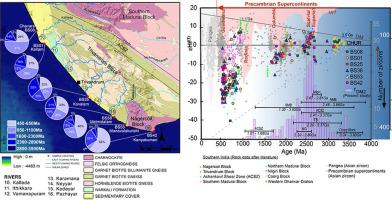Precambrian Research ( IF 3.8 ) Pub Date : 2021-09-06 , DOI: 10.1016/j.precamres.2021.106342 P.G. Athira 1, 2 , K. Sajeev 2 , Daniel J. Dunkley 3 , P.M. George 4 , Mingguo Zhai 5 , Ligang Zhou 5 , V.A. Ayisha 1

|
The southwestern coast of India is known for its rich beach placer deposits. So far, there have been no substantial attempts to determine the provenance of these deposits on a regional scale. Here we present for the first time geochronology, trace element chemistry and Hf isotope systematics of zircon and monazite from representative beach placer deposits along the southwestern coast of India to constrain provenance. Detrital zircon grains display a wide variety of ages, with modes in the ranges of 650–450 Ma, 1100–650 Ma, 2300–1600 Ma, 2800–2300 Ma and 3500–2800 Ma. A high proportion of ages fall within the Neoproterozoic–Late Cambrian range (1066–490 Ma). Growth zoning in zircon grains shows magmatic growth of many generations with ages affected by Neoproterozoic Pb loss, along with overgrowths typical of those formed during high-T metamorphism. Grains of metamorphic zircon, along with grains of monazite from the same samples of sediment, have strong modes between 570 and 470 Ma, indicating derivation from sources in the Southern Granulite Terrane affected by a major Late Neoproterozoic to Cambrian tectonothermal event. Mineral geochemistry of zircon grains indicates continental derivation, especially with older zircon from TTG-type sources. The geochemistry of late Neoproterozoic–Cambrian zircon and monazite are consistent with derivation from amphibolite to granulite-facies source rocks. Zircon ages and Hf isotope systematics can be ascribed to provenance from various source terranes exposed along the Western Ghats. This young rift-flank escarpment formed along the coast at a high angle to the distribution of different Precambrian terranes in the Indian Peninsula. Erosion promoted by a tropical climate and a steep coastal geomorphology, in combination with strong southward along-shore ocean currents, led to the concentration and distribution of heavy minerals from multiple sources along southwestern coast of India. The relative intensity of age modes in detrital zircon differs between localities, demonstrating differing inputs from proximal sources (from rivers dissecting steep terrain) versus distal sources from more northerly cratons and terranes brought to deposition sites by along-shore drift.
中文翻译:

印度西南部的沙滩砂矿:前寒武纪超大陆生长历史档案
印度西南海岸以其丰富的沙滩砂矿床而闻名。到目前为止,还没有实质性的尝试在区域范围内确定这些矿床的来源。在这里,我们首次介绍了来自印度西南海岸代表性海滩砂矿床的锆石和独居石的地质年代学、微量元素化学和 Hf 同位素系统学,以限制来源。碎屑锆石颗粒显示出多种年龄,模态范围为 650-450 Ma、1100-650 Ma、2300-1600 Ma、2800-2300 Ma 和 3500-2800 Ma。很大一部分年龄属于新元古代-晚寒武纪范围(1066-490 Ma)。锆石颗粒中的生长分带显示了随着年龄的增长,受新元古代铅损失的影响,以及高温变质过程中形成的典型过度生长的岩浆生长。变质锆石颗粒以及来自相同沉积物样品的独居石颗粒在 570 至 470 Ma 之间具有强模式,表明源自受新元古代晚期至寒武纪主要构造热事件影响的南部花岗岩地块中的来源。锆石颗粒的矿物地球化学表明大陆衍生,尤其是来自 TTG 型源的较老锆石。晚新元古代-寒武纪锆石和独居石的地球化学特征与从角闪岩到麻粒岩相烃源岩的衍生相一致。锆石年龄和 Hf 同位素系统学可以归因于沿西高止山脉暴露的各种源地体的来源。这个年轻的裂谷侧陡崖沿海岸形成,与印度半岛不同前寒武纪地体的分布呈大角度。热带气候和陡峭的海岸地貌促进了侵蚀,再加上强烈的向南沿海洋流,导致印度西南海岸多源重矿物的集中和分布。碎屑锆石中年龄模式的相对强度因地区而异,这表明来自近端源(来自切割陡峭地形的河流)与来自更偏北克拉通和地体的远端源的不同输入,这些源由沿岸漂移带到沉积地点。


























 京公网安备 11010802027423号
京公网安备 11010802027423号